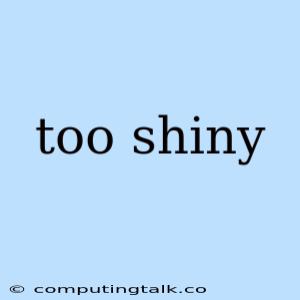The phrase "too shiny" can be interpreted in various contexts, depending on the situation and the object being described. It can be a subjective statement of opinion, a technical observation, or a critique.
Too Shiny: A Subjective Opinion
"Too shiny" can be a subjective opinion about the appearance of something. This is often used when describing objects like:
- Jewelry: A necklace might be considered "too shiny" if it's so sparkly it overwhelms the wearer or distracts from their overall look.
- Cars: Some people prefer a matte finish on cars, finding a "too shiny" paint job to be gaudy or too flashy.
- Clothing: A sequined dress could be considered "too shiny" for a casual event, while a satin shirt might be seen as too much for a formal gathering.
In these instances, "too shiny" is a personal preference based on taste and style. What's considered "too shiny" by one person might be perfectly acceptable to another.
Too Shiny: A Technical Issue
"Too shiny" can also be a technical observation used in various fields:
- Photography: A photo might be considered "too shiny" if it has too much glare or highlights, obscuring details in the image. This can be caused by overexposure, improper lighting, or a reflective surface in the scene.
- Metalworking: Metal can be "too shiny" if it has been polished to an extreme degree. While a high polish is desirable for some applications, it can be detrimental in others, causing unwanted reflections or even weakening the metal.
- Cosmetics: A makeup product might be considered "too shiny" if it creates an excessively glittery or oily appearance on the skin. This is often associated with products that are too heavily pigmented or contain excessive amounts of shimmer particles.
In these contexts, "too shiny" is an objective assessment related to technical factors like exposure, reflectivity, or the level of polish.
Too Shiny: A Critique
"Too Shiny" can also be used as a critique in various areas:
- Art: An artwork might be considered "too shiny" if it appears overly polished or lacks depth and texture. This could be due to the use of a glossy medium or a lack of layering and detail.
- Writing: A piece of writing could be considered "too shiny" if it seems overly polished and lacks authenticity or raw emotion. This might be due to excessive editing, a lack of voice, or an attempt to cater to a specific audience.
- Architecture: A building might be considered "too shiny" if it appears overly modern and lacks a sense of history or context. This could be due to the use of excessive glass and metal or a lack of traditional architectural elements.
In these cases, "too shiny" is used to express a sense of over-refinement or a lack of substance.
Overcoming "Too Shiny"
Depending on the context, there are various ways to address the issue of "too shiny". Here are some general tips:
- Reduce the amount of shine: This could involve using a matte finish, diffusing the light source, applying a less reflective coating, or simply adjusting the angle of the object.
- Add texture or depth: Introducing texture or layering can help break up the shine and create a more nuanced look. This could involve using a textured material, applying a distressed finish, or incorporating elements of depth and shadow.
- Focus on the substance: Instead of focusing on the surface, consider the underlying substance or meaning. This might involve highlighting the story behind the artwork, the emotions behind the writing, or the historical significance of the architecture.
- Embrace imperfection: Sometimes, embracing the flaws and imperfections of an object can create a more authentic and relatable experience. This could involve allowing some imperfections in the finish, using a more natural lighting, or incorporating elements of wear and tear.
Conclusion
"Too shiny" can be a subjective opinion, a technical observation, or a critique. It often points to a perception of excessive polish, reflection, or glare. Overcoming "too shiny" might involve reducing the shine, adding texture or depth, focusing on the substance, or embracing imperfection. Ultimately, the meaning of "too shiny" depends on the context and the individual interpretation.
